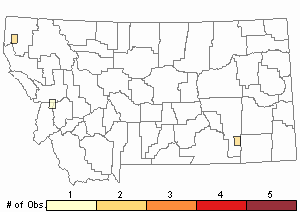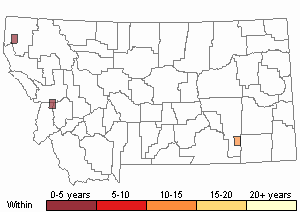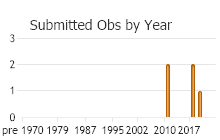View in other NatureServe Network Field Guides
NatureServe
Montana
Utah
Wyoming
Idaho
Wisconsin
British Columbia
South Carolina
Yukon
California
New York
A Noctuid Moth - Mesogona olivata
General Description
The Mesogona olivata forewing length is 15 – 20 mm. The ground color of the head, dorsal antennae, thorax, and forewing is variable, ranging from dull tan to reddish brown, gray-brown, or cream. The median area of the forewing and postmedian space at costa are darker than the ground color. The palpi have a mixture of ground color and dark scales. The forewing margin is crenulate. The forewing lines are double, smooth, and are filled with pale color. The basal line is sinuous and evident only near costa. The antemedian line is oblique and undulating. The outer line is dark. The postmedian line is smooth, and laterally convex. The subterminal line is sinuous and indistinct with a series of dark spots between the veins. The terminal line is thin and dark. The orbicular and reniform spots are large and pale with darker filling. The claviform spot is absent. The hindwing is variable with fuscous gray to reddish color that is always suffused with gray scales. Individuals from semi-desert locales tend to be pale while those from more mesic forest are darker (Powell and Opler, 2009).
Phenology
Mesogona olivata adults fly from late August to November, with the earliest flight in the northern part of its range (Powell and Opler, 2009).
Range Comments
This common species occurs from southern coastal and interior British Columbia south through California, Colorado and Texas (Powell and Opler, 2009).
Observations in Montana Natural Heritage Program Database
Number of Observations: 16
(Click on the following maps and charts to see full sized version)
Map Help and Descriptions
Relative Density

Recency



 (Observations spanning multiple months or years are excluded from time charts)
(Observations spanning multiple months or years are excluded from time charts)
Habitat
Mesogona olivata prefers dry open forest but also lives in shrub steppe and mesic forest habitats (Powell and Opler).
Food Habits
Mesogona olivata larvae feed on deciduous shrubs and trees which include oak, hazel, alder, and antelope brush (Powell and Opler, 2009).
Stewardship Responsibility
References
- Additional ReferencesLegend:
 View Online Publication
View Online Publication
Do you know of a citation we're missing? Powell, J.A. and P.A. Opler. 2009. Moths of Western North America. University of California Press, Berkeley, CA. 369 pp.
Powell, J.A. and P.A. Opler. 2009. Moths of Western North America. University of California Press, Berkeley, CA. 369 pp.
- Web Search Engines for Articles on "A Noctuid Moth"
- Additional Sources of Information Related to "Insects"





